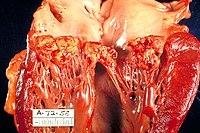
Photo from wikipedia
Trichosporon spp. are yeast-like organisms most often responsible for superficial skin infections (white piedra) and may transiently colonize the respiratory tract. Trichosporon asahii can be an opportunistic pathogen, causing invasive… Click to show full abstract
Trichosporon spp. are yeast-like organisms most often responsible for superficial skin infections (white piedra) and may transiently colonize the respiratory tract. Trichosporon asahii can be an opportunistic pathogen, causing invasive disease and sometimes disseminated infections, usually in immunocompromised patients. They are the third most commonly isolated yeast species in clinical settings. They cause hemorrhagic and necrotizing bronchopneumonia due to vascular invasion; mycotic emboli are identified within hemorrhagic infarcts. Distinctive pleomorphic budding yeasts, true hyphae, and arthroconidia stain weakly with silver stain in tissue. A 53-year-old HIV-negative male with PMH of schizophrenia and intravenous drug abuse presented with shortness of breath and chest pain. Patient was admitted to the MICU for acute respiratory distress likely secondary to pneumonia. Chest CT scan revealed multiple ill-defined opacities in the lung periphery. The patient had neutrophilic leukocytosis and positive blood culture for methicillin-resistant Staphylococcus aureus and Candida glabrata. Broad-spectrum antibiotics and antifungal drugs (fluconazole, voriconazole, amphotericin B, micafungin) were started. Two weeks later, wedge lung biopsy revealed necrotizing pneumonia with abscess formation and pleomorphic budding yeast-like cells, measuring 3 to 6 microns in diameter; septated hyphae; and arthroconidia. Culture of a bronchial washing was confirmed to be T asahii by matrix-assisted laser desorption/ionization time of flight (MALDI-TOF). Unfortunately, the patient died and partial autopsy of his lungs showed the same pathogen. Invasive respiratory infections caused by T asahii have increased in frequency over the last two decades. Distinctive histology in tissue (pleomorphic yeasts, septated hyphae, and arthroconidia) can suggest the diagnosis, confirmed with MALDI-TOF. Risk factors for invasion include prior antibiotic therapy, central catheterization, malignancy (often hematologic), and intensive care unit admission. Thirty-day all-cause mortality has been reported to be 42% and has been linked to resistance to amphotericin B and echinocandins.
Journal Title: American Journal of Clinical Pathology
Year Published: 2019
Link to full text (if available)
Share on Social Media: Sign Up to like & get
recommendations!